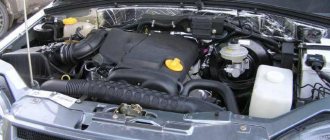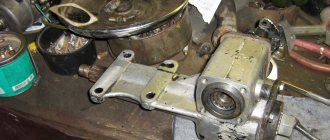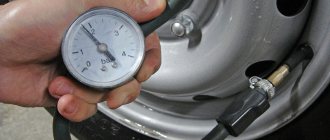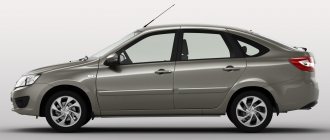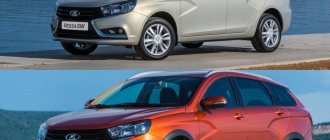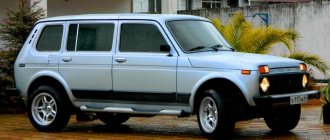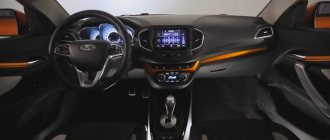The bottom is in good condition.
After the purchase I began to put it in order.
The first person who has driven a Niva will understand the disease.
The transfer case, gearbox, etc., everything nearby were also removed.
The village craftsmen rolled the threads on the studs under the box and transfer case.
after replacing oil seals, gaskets, broken bolts and nuts. The box and transfer case took their place.
Next, the suspension went into disarray. Everything was cracked, I replaced boots, springs, seals, ball and wheel bearings, shock absorbers. Steering rods. etc.
Well, I immediately decided to raise the slippers to 30.
Next, I shook up the entire ignition system. New coil, armor, switch, spark plugs, etc.
I even tried on 33rd wheels.
Price: 35,000 ₽ Mileage: 50,000 km
Lada 4x4 3D 2000 - do it yourself
Cars for sale
Lada 4×4 2121 Niva, 2019
Lada 4×4 2121 Niva, 2016
Lada 4×4 2121 Niva, 2014
Lada 4×4 2121 Niva, 1997
see also
Comments 19
thanks for the advice
Please help if you know. Why does my VAZ-2121 turn more to the right and less to the left? Maybe some lever lengths?
And while driving it doesn’t pull in any direction? And so, offhand, here we need to reduce the left steering lever by an equal length and increase the right one. In this case, the steering wheel should turn. Well, the steering gear itself, although its travel is limited by the travel of the rods. Something like this.
Please help if you know. Why does my VAZ-2121 turn more to the right and less to the left? Maybe some lever lengths?
The bipod of the steering column is not in the center. The treatment is as follows: you turn the steering wheel all the way to the left, counting, then to the right, then you find the middle. The middle is the straight position of the column. In this position, you adjust the steering rods so that the wheels are straight, the toe is 2-4 mm. After unscrew the steering wheel, move it according to movement, tighten it, that's it
Niva is the first development of AvtoVAZ, completed entirely independently. Niva is an all-wheel drive off-road passenger car. Its technical characteristics and design features (permanent all-wheel drive, significant ground clearance, small body overhangs) allow the vehicle to be used in addition to the paved road network also in off-road conditions and on terrain with complex surface topography. The car's outstanding all-terrain qualities have been repeatedly tested and confirmed. In all extreme situations, Niva behaves predictably, confidently and purposefully. Functionally, the Niva is quite suitable for transporting goods. With the rear seat folded down, trunk volume increases significantly.
VAZ-21213 and VAZ-21214 cars are comfortable, high-speed, compact, all-wheel drive off-road passenger cars designed for transporting passengers and cargo on roads with all types of surfaces and dirt roads. The cars combine the high cross-country ability of an all-terrain vehicle with all-wheel drive with the convenience, comfort, dynamics and speed qualities of a modern passenger car.
Compound
1. Headlight; 2. Front light; 3. Jack; 4. Radiator; 5. Windshield and headlight washer reservoir; 6. Engine; 7. Air filter; 8. Cooling system expansion tank; 9. Rechargeable battery; 10. Differential lock lever in the transfer case; 11. Gear shift lever; 12. Gear shift lever in the transfer case; 13. Steering wheel; 14. Front seat; 15. Rear seat; 16. Rear window washer reservoir; 17. Main muffler; 18. Rear bumper; 19. Rear brake; 20. Rear suspension spring; 21. Rear shock absorber; 22. Rear suspension transverse rod; 23. Longitudinal reaction rod of the rear suspension; 24. Fuel tank; 25. Rear axle; 26. Additional muffler; 27. Rear driveshaft; 28. Brake fluid reservoir; 29. Clutch fluid reservoir; 30. Transfer case; 31. Clutch pedal; 32. Brake pedal; 33. Front brake; 34. Front suspension spring; 35. Front axle; 36. Side turn signal; 37. Front bumper.
The engine, clutch housing and gearbox are interconnected and form a power unit, which is mounted on the car at three points on rubber cushions.
The engine is a four-stroke, carburetor, in-line, with an overhead camshaft. Compared to the VAZ-2121, the engine power has been increased, making it better able to adapt to load changes.
Basic systems
Engine lubrication system – with full-flow oil filter.
The cooling system is liquid, closed type. The system includes a body heater, which receives fluid from the cylinder head and is discharged to the pump. The coolant is a special one with a low freezing point and a high boiling point. The radiator is aluminum with better heat transfer characteristics and is more technologically advanced than the brass radiator of the VAZ-2121.
The power system includes an air filter, fuel tank, fuel pump and carburetor. The fuel tank is located under the rear seat. The carburetor is equipped with a high-efficiency dry-type air filter with a paper filter element.
The carburetor is installed as a “Solex” type, similar to that used on VAZ 2108 - 2109 cars. This carburetor, in combination with a contactless ignition system, reduces fuel consumption.
Historical reference
The VAZ 2121 car first appeared in public in 1977.
In its first configuration the car had:
- Power unit from VAZ 2106 with a volume of 1580 cc and a power of 80 hp;
- 4-st. gearbox;
- Permanent all-wheel drive;
- Load-bearing all-metal body;
- Interior of a passenger car (from VAZ 2106).
Later, the car received a modernized engine with an increase to 1690 cc. cm volume, and increased to 82 hp. power.
The new modification received the factory index - VAZ 21213, and had differences in:
- Power system - a Solex carburetor was installed on the model;
- Ignition system - the car was equipped with a contactless ignition system built on a microcontroller;
- Equipped with a silumin oil radiator.
For reference: a new carburetor and contactless ignition reduced fuel consumption, but increased oil consumption. And since in those years the price of oil was insignificant, car owners were not afraid of this feature.
Transmission
The clutch is a single-plate, dry clutch with a diaphragm pressure spring and a hydraulic release drive. Gearbox – mechanical, three-way, five-speed. The transfer case is a two-stage three-shaft with an interaxle lockable bevel two-satellite differential.
The intermediate driveshaft connecting the gearbox to the transfer case has an elastic coupling and a constant-velocity universal joint. The cardan shafts of the rear and front axles at the ends with cardan joints on needle bearings with grease fittings transmit torque from the transfer case to the main gears of the axles.
The main gears of the front and rear axles consist of a pair of bevel gears with spiral teeth of hypoid engagement. Differentials - conical two-satellite.
Car device
VAZ-21213 and VAZ-21214 cars are comfortable, high-speed, compact, all-wheel drive off-road passenger cars designed for transporting passengers and cargo on roads with all types of surfaces and dirt roads. The cars combine the high cross-country ability of an all-terrain vehicle with all-wheel drive with the convenience, comfort, dynamics and speed qualities of a modern passenger car.
The engine, clutch housing and gearbox are interconnected and form a power unit, which is mounted on the car at three points on rubber cushions.
The engine is a four-stroke, carburetor, in-line, with an overhead camshaft. Compared to the VAZ-2121, the engine power has been increased, making it better able to adapt to load changes.
Engine lubrication system - with full-flow oil filter.
The cooling system is liquid, closed type. The system includes a body heater, which receives fluid from the cylinder head and is discharged to the pump. The coolant is a special one with a low freezing point and a high boiling point. The radiator is aluminum with better heat transfer characteristics and is more technologically advanced than the brass radiator of the VAZ-2121.
The power system includes an air filter, fuel tank, fuel pump and carburetor. The fuel tank is located under the rear seat. The carburetor is equipped with a high-efficiency dry-type air filter with a paper filter element.
The carburetor is installed as a Solex type, similar to that used on VAZ 2108 - 2109 cars. This carburetor, in combination with a contactless ignition system, reduces fuel consumption.
Transmission. The clutch is a single-plate, dry clutch with a diaphragm pressure spring and a hydraulic release drive. Transmission - mechanical, three-way, five-speed. The transfer case is a two-stage three-shaft with an interaxle lockable bevel two-satellite differential.
The intermediate driveshaft connecting the gearbox to the transfer case has an elastic coupling and a constant-velocity universal joint. The cardan shafts of the rear and front axles at the ends with cardan joints on needle bearings with grease fittings transmit torque from the transfer case to the main gears of the axles.
The main gears of the front and rear axles consist of a pair of bevel gears with spiral teeth of hypoid engagement. The differentials are two-satellite conical.
The front wheel suspension is independent, lever-spring, with coil springs, telescopic hydraulic shock absorbers and a stabilizer bar.
The rear wheel suspension is a rigid beam connected to the body by one transverse and four longitudinal rods, with coil springs and hydraulic telescopic shock absorbers.
Steering - worm gear and three-link steering gear with one middle and two side rods.
Brakes. The front ones are disc with a movable caliper. The rear ones are drums with self-centering shoes and a pressure regulator. The service brake drive is hydraulic foot, with a vacuum booster, dual-circuit. The parking brake is manual with a cable drive on the rear brake pads.
The electrical equipment of cars is made according to a single-wire circuit, in which the negative terminals of sources and consumers of electricity are connected to ground, which acts as a second wire. The current sources in the system are an alternating current generator with a built-in semiconductor rectifier and a microelectronic voltage regulator and a 6ST-55 lead-acid battery. To start the engine, a starter 35.3708 is used.
The car body is of a supporting structure, three-door, all-metal. The body shell is a welded structure assembled from panels, side members, cross members, struts and various reinforcements.
Side doors with a front hinge have two safety glasses: the front one is rotating with a handle and a lock, the rear one is sliding glass driven by the window lifter handle. The tailgate is hung on the body on two hinges and is locked with a lock. The door is held in the open position by gas-filled stops. The rear door sill is lowered to the level of the bumpers, making it easier to load and unload cargo.
Window and rear windows with panoramic glass. The windshield is polished, three-layer, and the back and sides are hardened.
The front seats are separate with reclining backrests and have a mechanism for adjusting the seat position and backrest tilt. The rear seat is common and folds down to form a cargo area.
The VAZ-21214 differs from the VAZ-21213 by installing an engine with a fuel injection system. This system ensures compliance with 1983 US emissions regulations and also improves vehicle performance. Changes to the engine concern the power supply system, ignition and exhaust gases. Features of the fuel injection system are described in section Fuel injection 21214
.
| Technical characteristics of VAZ-21213, 21214 cars | |
| Number of seats including driver's seat | 4 |
| Load capacity, kg | 400 |
| Weight of the equipped vehicle, kg | 1210 |
| Base (distance between axes), mm | 2200 |
| Wheel track, mm: front rear | 1430 1400 |
| Vehicle clearance at full load and normal tire pressure, mm: to the front suspension cross member to the rear axle beam to the engine crankcase | 288 220 319 |
| Overall dimensions, mm: length width height (without load) | 3740 1680 1640 |
| Maximum speed in top gear, km/h: with total vehicle weight with driver and one passenger | 135 137 |
| Acceleration time of a car from a standstill with gear shifting to a speed of 100 km/h, s: with the total weight of the car with a driver and one passenger | 21 19 |
| Smallest turning radius along the track axis of the front outer wheel, m: | 5,5 |
| Braking distance of a car with a full load from a speed of 80 km/h on a horizontal section of a dry, level asphalt highway, m | 40 |
| Engine model | 21213 21214* |
| Cylinder diameter and piston stroke, mm | 82x82 |
| Working volume, l | 1,7 |
| Compression ratio | 9,3 |
| Rated power according to GOST 14846 (net) at a crankshaft speed of 5200 (5400*) rpm, hp. | 78,9 |
| Gearbox ratios: first second third fourth fifth reverse | 3,67 2,1 1,36 1,00 0,82 3,53 |
| Final drive ratio (both axles) | 3,9 |
| Transfer case ratios: high gear low gear | 1,2 2,135 |
| Wheel rim size | 127J-406 (5J-16) |
| Tires | diagonal 175-406 (6.95-16) or radial 175/80R16 |
| * For VAZ-21214 car | |
continuation>>
Announcements of articles from friendly sites
Body
The car body is of a supporting structure, three-door, all-metal. The body shell is a welded structure assembled from panels, side members, cross members, struts and various reinforcements.
Side doors with a front hinge have two safety glasses: the front one is rotating with a handle and a lock, the rear one is sliding glass driven by the window lifter handle. The tailgate is hung on the body on two hinges and is locked with a lock. The door is held in the open position by gas-filled stops. The rear door sill is lowered to the level of the bumpers, making it easier to load and unload cargo.
Window and rear windows with panoramic glass. The windshield is polished, three-layer, and the back and sides are hardened.
The front seats are separate with reclining backrests and have a mechanism for adjusting the seat position and backrest tilt. The rear seat is common, folding to form a cargo area.
The VAZ-21214 differs from the VAZ-21213 by installing an engine with a fuel injection system. This system ensures compliance with 1983 US emissions regulations and also improves vehicle performance. Changes to the engine concern the power supply system, ignition and exhaust gases. Features of the fuel injection system are described in section Fuel injection 21214.
Due to the use of complex technological equipment and the need for high-quality work, it is recommended that the treatment of hidden cavities be performed only at car service stations.
The procedure for performing operations to protect hidden cavities from corrosion:
- place the car on a lift, remove parts and upholstery that prevent access to hidden cavities;
- rinse with water at a temperature of 40-50°C through the technological and drainage holes, hidden cavities (Table 8-2) and the bottom of the body until clean water flows out. In this case, the sliding windows of the doors must be raised;
- remove moisture that has entered the passenger compartment and luggage compartment, blow with compressed air all areas where the anti-corrosion compound was applied;
- Drive the car into the chamber for applying the anti-corrosion compound and place it on a lift. Spray anti-corrosion compound to the areas shown in Fig. 8-6, 8-7 and 8-8;
- lower the car from the lift, clean the front surfaces of the body from dirt with a rag soaked in white spirit.
Rice. 8-6. Hidden cavities (front view of body):
1 — upper cross member of the front end; 2 — headlight housings; 3 — lower cross member of the front end; 4 — under the front wing; 5 — external threshold; 6 - internal threshold.
Rice. 8-7. Hidden cavities (rear view of the body):
1 — rear side members; 2 - between the rear wheel arches and the sidewalls; 3 — rear side members; 4 — rear floor cross members; 5 — central pillars; 6 — front door pillars; 7 - door pocket.
Rice. 8-8. Hidden cavities (body view from below):
1 — front side members; 2 — connectors of the front side members; 3 — middle spars; 4 — connectors for middle side members; 5 — cross members of the rear floor; 6 — rear side members; 7 — rear cross members.
Looking back at the year of my life completely spent on the Niva, I remember what was done and what should have been done differently... And some things, probably, we did in vain...
I DON'T HAVE TO DO IT AS BEST, DO IT AS WELL!
Lada 4x4, VAZ-21214, as well as all other SUVs that we historically call “Niva”, have several obvious advantages and no less obvious disadvantages, most of which are revealed only during operation. For some time now, the main advantage of the Niva has been its price. Let me remind you that this was not always the case and, for example, in Soviet times, a VAZ-2121 cost 9,900 rubles, only slightly inferior to the Volga in this indicator. In fact, it was the only versatile SUV on the market. LuAZ was completely utilitarian, and buying a UAZ for private ownership was extremely difficult, that is, almost impossible. At the same time, if we remember that a Zhiguli, say, the fifth model, cost 5,300, then it becomes clear why there were no queues for the Niva. In the late eighties, the VAZ-2121 was even sold in installments (as, by the way, was the Moskvich). Now try to find a Niva of that time in decent condition! And especially in determining this decent condition is the body. This is the first thing I strongly recommend that a young man who is planning to buy a VAZ SUV pay attention to. And I don’t even mean the presence of rust, the strength of the side members and other strength elements, but the mandatory and indispensable anti-corrosion treatment. Even if the body is strong and the “red plague” is not visible, believe me, half of the winter it will appear even in a five-year-old car. The body of the Niva is load-bearing - that is, each element is, in fact, a force-bearing one. Any corrosion, especially advanced corrosion, especially through corrosion, plus vibration, plus loads when driving off-road - and then only expensive body repairs with reinforcement, welding, aluminum linings and scary-looking “extenders” of wheel arches. So, the first stage is anti-corrosion. You may ask, is it worth filling your car with popular and varied protective coatings? Yes, if you have money and the first stage is completed perfectly. This is beautiful, practical and well complements the preservation of the body, since the paintwork scratches easily and blooms instantly (you can read about a similar experience with our Niva and Titan in issue No. 12/2016 of our magazine).
Just step on the gas a little and damage is inevitable.
THE NIVA'S BODY IS SUPPORTING - THAT IS, EVERY ELEMENT IS, IN ESSENCE, POWER-BASED
The second thing to do is replace the main pairs. Even if you spend most of your time on the pavement, you may need a little more traction on one of your longer trips. For example, somewhere in the mountains or foothills. You press the gas, press it some more - it seems to be going, acceleration, impact... the cardan splits in half, the journey is over. You won't get far with front-wheel drive. And if you took your time, carefully, then perhaps you would see not a picture of a broken cardan, but the Lago-Naki plateau. Which specific pairs are needed depends on the circumstances: universal 4.1, if the wheels remain within 28 inches, starting from 29 and larger - 4.3. It is important to remember that it is not only the search for quality parts that causes difficulties, but also their installation. If possible, take assembled gearboxes. Better than the Soviet ones. They are found at showdowns and in “penny for spare parts” advertisements. It’s even better to supplement the traction main pairs with a tuning kit for the transfer case with a lower 2.95. But such a reduction will require the driver to think more with his head than to work with the pedal, since axle shafts and CV joints are also not eternal.
Now only expensive body repairs with reinforcement and welding will help
YOU DON'T NEED UNLOADED HALF AXLES, NIVA IS NOT A TRUCK
Strengthening the chassis - part three. You most likely do not need unloaded rear axle shafts. This is the prerogative of trucks with a large workload. Finding high-quality “reinforced” ones is also not easy. They complain about all manufacturers, but, in principle, forward - non-adjustable hubs with sealed bearings “like Iveco”, back - axle shafts, say, from Izhevsk. Of course, no one bothers to tighten the hub bearings every 30-40 thousand kilometers, however, after driving through fords, muddy ruts and puddles, we can face the rapid death of the mentioned bearings literally within a couple of hundred kilometers on the highway. Behind the general noise of the Niva, the roar of the transmission and the howl of mud tires, the sound of wear may not be noticed, and you will immediately get a replacement. Non-adjustable hubs are sealed, this is their main advantage. As for the rear axle shafts, it is a matter of faith that this will help. But it’s definitely worth strengthening the bridge. Especially on a long Niva, heavy load or gas equipment. Sometimes the bridge bends when driving onto a curb unsuccessfully, not to mention off-road use and expeditionary conditions, when the load on the car is maximum. Even a bend invisible to the eye can lead to permanent problems with axle shafts and gearboxes. Hypothetically, you can check the axle on a wheel alignment stand, or you can “clear it” by removing the axle shafts.
Read also: Repair of the front spar Niva 21213
EXPERIENCED NIVA GROWERS SAY THAT NIVA IS GOOD IN STOCK, BUT ELEVATOR IS EVIL
The elevator is another popular reason for battles. Opinions are polar! We made a 40 mm lift, lengthened the bump stops and did not notice any negative consequences. Yes, maybe 8 cm spacers and springs from a Chevrolet Suburban are too much, but 40 mm is what you need. What's the point, you ask? Increased ground clearance in the base. For a long car this is critical. The maximum wheels that can be installed without cutting the arches are 215/75 R15, or, as in our case, 215/65 R16. More - cutting or lifting will be required, and more often both. Cutting arches is another stumbling block for Niv owners. But everything is simple here: if you are not going to resell the car for maximum profit, you are not going to install wheels larger than the ones above, then you don’t need cutting. But starting from 225/75 R16 or 235/75 R15, it is better to shorten the arches. At the same time, it is important that at the back, where the panels go end-to-end, there is not just sealant, but riveting or welding with the obligatory anti-corrosion agent.
Do you have to change rear axle bearings often? Check if the bridge is bent
We change the hubs to non-adjustable ones
It is very useful to install underbody protection. It is not necessary to “ski” from the bumper to the rear axle, but it is better to cover the engine compartment, transmission and, if you drive on rocks, the transfer case. We chose a light alloy, but steel will be cheaper. It is important to pay attention to ensure that dirt does not accumulate on the protection, which can significantly impair the cooling of units in the summer. What I categorically do not recommend doing is hanging the Niva with iron. Power bumpers, sills, an expeditionary trunk, a ladder, a bracket for a spare wheel, a mount for a canister, a jack, a shovel and sand trucks - that's an extra 200 kg for your car. And yet, even if you replace the generator, you should not abuse additional light. Fog lights, work lights, reverse gear - that's all. Needless to say, preference should be given to LED lights. In addition, I recommend replacing the standard headlights with sealed ones, they are available for sale. And you definitely shouldn’t mess around with xenon.
EVEN ON A SHORT “NIVA” YOU CAN PAINLESSLY INSTALL GAS EQUIPMENT
Of particular interest was the installation of gas equipment. We listed detailed pros and cons in the material on this topic (can be found on the website or in free archived issues on the App Store or Play Market). There were more advantages. A year and a half of operation confirms our conclusions. A kilometer of run is almost half the price, and the installation paid for itself a long time ago. Even a short Niva can be equipped with gas if you remove the cylinder under the bottom and protect it from behind with a tow bar. After the lift, there is almost 350 mm of ground clearance under the cylinder, and this does not interfere with off-road conditions. It is clear that if you are taking a car for sports, then it is better not to do this - in such a situation, every kilogram counts.
The Niva doesn’t need unloaded axle shafts, but reinforced ones won’t hurt
Wheels with a diameter greater than 29 inches require both a lift and arch cutting
CHIP TUNING IS USEFUL, BUT IT'S ALWAYS A COMPROMISE
Many Niva owners doubt the need for chip tuning and boosting the engine. I can’t recommend boring the block to 2.0 liters, but I fully approve of the low-level camshaft, the corresponding engine control program and the 4-2-1 exhaust manifold. Carburetor cars, in addition to the shaft and exhaust, definitely need to look for more high-torque main pairs. As for our Niva, I was quite satisfied with the chip tuning. And even though the car didn’t fly, it crawled much more confidently. By the way, the purchase of a snorkel can be timed to coincide with the work on the engine, and the installation of the protection units can be accompanied by the removal of unit breathers. Yes, and no one has canceled the snorkel from sanitary products yet. If you don’t want to cut the hood or fender, buy a corrugation from Priora and replace the standard pipe by bending the corrugation up towards the hood - you’ll get an additional thirty centimeters of fording depth for a hundred rubles. If funds allow, it is worth moving the generator higher, replacing it with a more modern and powerful one. The spare tire, however, will have to be removed from under the hood, say, onto the top trunk.
I wanted to write about the salon, but stopped in time... I will limit myself to only recommending replacing the seats with foreign ones. In general, for any, the main thing is to get rid of the factory ones! Believe me, you won't regret it! And in general, I must admit, “Niva” provides amazing scope for creativity, not limited by anything other than technical regulations and budget. The main thing is not to forget that the best is sometimes the enemy of the good!
Even a short Niva can be equipped with gas if you remove the cylinder under the bottom and protect it from behind with a towbar
This car was able to change the idea of what a compact all-terrain vehicle should look like not only among residents of the Soviet Union, but also among the countries of the Western world. Luck has accompanied the domestic car since its creation and still guides it along the path of world history, reinforcing the treasury of achievements with new victories.
The history of the VAZ 2121 begins in 1972. At the same time, thoughts about an affordable all-terrain vehicle for citizens of the USSR appeared among the country's leadership since the late 1960s. The Soviet Union urgently needed a “rogue” that was accessible to the vast majority of the population and had excellent performance both on and off the pavement.
This desire was caused by the fact that the road network of the USSR was in an underdeveloped state, and the quality of the roads themselves left much to be desired. And, in 1970, by decree of Alexei Kosygin, a tender was created for the construction of a machine that meets the necessary requirements. The development of the all-terrain vehicle was carried out by three manufacturers at once - AZLK, IzhMash, AvtoVAZ. The latter was able to present the most interesting version of the future Niva.
Read also: The best comprehensive insurance in Moscow
Lada 4×4 was created on a radically new platform, which had not previously been used either at AvtoVAZ or anywhere else. For its time, the all-terrain vehicle had revolutionary technical characteristics and became a vivid embodiment of progress in the global automotive industry. In particular, all-wheel drive was permanent, the suspension was made independent, and the body was made load-bearing. All this was supported by an attractive design, as well as a comfortable interior.
Lada Niva underwent sea trials in the Ural Mountains and in the vast expanses of Central Asia. It is noteworthy that the SUV passed all the necessary tests quite well. However, compared to the more serious Land Rover and UAZ, it turned out that the new product feels very confident when driving on bumpy terrain, while difficult long sections are less easy for the car.
In 1975, a decree was signed to put the new Lada on the assembly line. In 1976, the first batches of cars rolled off it. Full-scale production of the model began in 1977.
An interesting fact is that the vast majority of VAZ 2121 produced were exported to other countries from the first years of production (up to 80 percent of the total volume of cars produced were supplied to foreign markets). At the same time, in the USSR itself, all-terrain vehicles remained in short supply for some time. The model was in high demand in Germany, Great Britain, the Benelux countries, and Japan.
For foreigners, the Lada Niva has become the standard of an affordable SUV that can be safely used in a variety of conditions.
Civil (main) modifications for the countries of the USSR/RF and the CIS:
- 21211. This car was equipped with a 1.3 liter engine that produced 69 horsepower.
- 2121. The main modification of the all-terrain vehicle until 1993. It features a 1.6-liter power plant with a capacity of 80 horsepower.
- 21213 "Taiga". Restyled version of the Niva (since 1993). It features different rear lighting optics and an updated interior. A modernized 1.7 liter engine is installed, producing 83 horsepower. The latter is combined with a five-speed manual transmission.
- 21214. A 1.7 liter power unit with a fuel injection system is installed (since 2002). The car meets European environmental standards.
Special variations intended for civilian use:
- Lada 4×4 “Lynx”. The factory tuning version of the domestic all-terrain vehicle debuted in 2009. This model differs from the standard version by extended wheel arches and larger side-view mirrors. The main feature is the screw-type self-locking differentials installed on the front and rear axles.
- Lada 4×4 Urban. This crossover entered the market in 2014. The exterior is notable for its different radiator grille, bumpers, rear pillar trims and unique color scheme. The Urbana salon received a new steering wheel, air conditioning system, electric windows and side mirrors.
VAZ-2121 Niva: from sadness to joy
I sold my last Niva ten years ago, after an asphalt road to my summer cottage appeared. But in the year of the fortieth anniversary of the car, with which, it turned out, so much was connected in life, I decided to share my memories.
LADA > 4×4
The reason was a call from Kostya, a young architect, the son of my friends, in love with Niva, asking for help finding tires for his car. It turned out that all this time in the summer he was driving on my tires, which I gave to them after selling my Niva.
I'll start with Nivov tires. Everyone knows that the standard VLI-5, which was equipped with the Niva, was poorly suited for driving on asphalt due to the terrible noise and insufficient traction properties on dry asphalt, and it wore out quickly. To make the ride comfortable, it was necessary to immediately change the tires. Have you tried to find them in the standard 16-inch size for the Niva?
This is still a problem, except for the Kama tires, which are difficult to balance. So I installed Bridgestone tires designed for delivery vans. Having traveled 30 thousand kilometers on my Niva, these tires drove about fifty more on two Nivas in Kostya’s family. Many tire drivers switch to 15-diameter tires to solve the tire problem, but this requires replacing the standard rims. However, such a transition, in turn, gives rise to the problem of placing a spare wheel under the hood. That is why there are options for mounting the spare tire on the rear door.
Owner reviews: what are the pros and cons of the model?
VAZ 2121 is deeply loved all over the world. Legends are made about this car and it is cultivated. Practice has shown that the Russian all-terrain vehicle has a reliable chassis that can withstand extreme use on a wide variety of roads and terrain.
In addition, the model’s high maintainability is also valued - some components and assemblies can be repaired literally in an open field. A minimum of electronic systems guarantee trouble-free operation of the vehicle in harsh climates.
The disadvantages include the low resistance of the body to corrosion. And yet, many criticize the Niva for its mediocre acoustic comfort, which makes long trips on it unbearable. The owners are trying in every possible way to improve this design flaw and install additional sound insulation. Detailed information about this is presented in numerous articles and videos on the Internet.
Protection of side members from water and dirt
Water can also get onto the side members from the wheels of the Niva. Standard fender liners (lockers) are not able to protect them fully. We finalize the design by installing plugs made of pieces of plastic or rubber into the opening:
Comprehensive modifications will help protect the Niva’s engine compartment from moisture and dirt, which will significantly extend the service life of parts. Have you modernized the engine compartment this way? Let us remind you that the website provides other instructions for improving the domestic SUV, for example, installing a gas stop on the hood, or how to protect the Niva’s gas tank from thieves.
Market price
Under the USSR, the average cost of a domestic all-terrain vehicle was nine thousand rubles. At the moment, the car is already obsolete.
However, it is still considered one of the most expensive in the AvtoVAZ line:
| Auto | State | Price (rubles) |
| VAZ 2121 | new | from 480 thousand |
| VAZ 2121 | boo | from 45 thousand |
Test Drive
Timeless motives
At the time it went on sale, Lada Niva was one of the most beautiful cars of its time. Now square body shapes, round lighting optics and laconic bumpers are already classics that evoke a feeling of pleasant nostalgia.
However, the creators calculated everything perfectly. Short body overhangs and non-protruding bumpers provide outstanding geometric cross-country ability. A minimum of plastic parts reduces the risk of damage during extreme use, and the ground clearance of 220 millimeters makes it possible to navigate deep ruts and mountainous terrain.
Nothing extra
The interior is simple but functional. The instrument panel with analog scales and a tachometer is perfectly readable due to large digitization, and is also quite informative. On the center console there is a climate system unit in the form of sliders, as well as control keys for light and rear window heating - they are organized compactly and there are no problems with their use. Ergonomic miscalculations include a pedal assembly shifted to the right, as well as a significant distance to the manual transmission lever.
The front seats have no profile. However, they are comfortable to sit on due to optimal rigidity and the presence of lateral support rollers. But the back seat is cramped in all directions, even with a height of 165 centimeters. The initial volume of the luggage compartment is 265 millimeters. When the second row seats are folded, the figure increases to 585 liters.
Subspecialist
You can drive the VAZ 2121 quite confidently on an asphalt highway. The 1.7-liter fuel-injected engine (83 horsepower) pulls confidently at low and medium speeds, and the optimally selected transmission ratio makes it possible to accelerate well at speeds of up to 70 kilometers per hour. At the same time, the clarity of gear shifts is mediocre, and the moves of the manual gearbox lever are very sweeping.
The steering with low sensitivity is not very informative, and the steering wheel itself rotates with noticeable effort. The latter causes discomfort when maneuvering in city conditions. At high speeds, the car yaws along the road, as well as significant rocking.
The main disadvantages of driving comfort are vibrations and annoying hum from the engine and transmission. Also, above 80 kilometers per hour, aerodynamic noise begins to appear, which forces you to seriously raise your tone when communicating with the rest of the occupants of the cabin. In a word, lovers of long-distance travel will not be delighted with the VAZ 2121.
But everything changes - you just have to drive onto a country road. Having felt its native elements, the Niva begins to surprise the driver with an energy-intensive suspension that provides excellent ride comfort, as well as absolute immunity to road irregularities. At the same time, the transfer transmission coupled with all-wheel drive allows you to successfully get out of sticky mud, clay or sand.
Giz69 › Blog › Getting to know the Lada 4*4 URBAN (Part 3. under the hood)
I will continue the epic journey of getting to know this wonderful car.
This time let's see what's under the hood =) We open the hood, and there...
And there is a good old jumper with a volume (according to the manufacturer 1.7 liters 8 valves) and a power of as much as 83 horsepower. Of course this is not a super car! This is not even the Chinese parquet of Cherry Tigo with its, if memory serves, 126 fillies. But again, according to reviews from the owners, this engine is quite enough in the city and countryside. But given the fact that now there’s also an air conditioner under the hood, I can vaguely imagine how this little guy will handle everything =)) The actual air conditioner compressor was placed right above the steering wheel, thereby stealing another piece of living space under the hood.
Also, among the latest achievements of the automotive industry, I would like to note the installed electronic gas pedal unit. Still, a tribute to environmental standards...
Otherwise, under the hood it’s a good old clunker who screams with all his existence: “I’m old! I’m very old!” =)) You can even feel this in the example of attaching hoses to the body =) To prevent anything from dangling, ordinary technical adhesive tape was used, glued somehow crookedly.
Then what catches your eye are the hoses running right on top of the valve cover. God bless him with the hoses, which were not hidden anywhere, but it was possible to make normal fastenings for all this goodness? :) Although this also does not affect the functionality.
They continue to cover the wiper motor with some piece of rubber obscenity. Maybe this is a tribute to fashion? How do they say “Old School” now? :)
Further more. The jack remained the same and in the same place.
Fuck him with the jack and his work, but I don’t understand why it rests so directly on the wiring of the dimensions.
Although maybe it can be moved or thrown into the trunk and then the wiring won’t be in any danger =) I’ll definitely warn the owner about this jamb!
I also managed to discover and still don’t really understand WHAT IS THIS? some tubes “from a dropper” sticking out in the engine compartment.
What else is left under the hood? One of the niceties on the hood itself is a well-glued heat reflector.
Maybe they now glue it on regular Lada 4*4s, but on an old car this element is definitely not there!
These are the pies URBAN has under the hood. In general, I didn’t see anything critical, but I couldn’t spot any innovations either. In a word - conservatism!
The review under the “skirt” did not fit, so there will be a separate post.
Source: www.drive2.com
